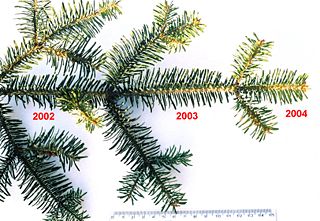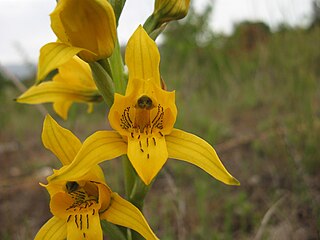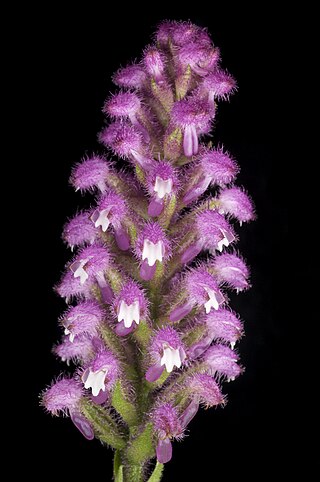
Flowering plants are plants that bear flowers and fruits, and form the clade Angiospermae, commonly called angiosperms. They include all forbs, grasses and grass-like plants, a vast majority of broad-leaved trees, shrubs and vines, and most aquatic plants. The term "angiosperm" is derived from the Greek words ἀγγεῖον / angeion and σπέρμα / sperma ('seed'), meaning that the seeds are enclosed within a fruit. They are by far the most diverse group of land plants with 64 orders, 416 families, approximately 13,000 known genera and 300,000 known species. Angiosperms were formerly called Magnoliophyta.

Orchids are plants that belong to the family Orchidaceae, a diverse and widespread group of flowering plants with blooms that are often colourful and fragrant. Orchids are cosmopolitan plants that are found in almost every habitat on Earth except glaciers. The world's richest diversity of orchid genera and species is found in the tropics.

Sex is the trait that determines whether a sexually reproducing organism produces male or female gametes. A male organism produces small mobile gametes, while a female organism produces larger, non-mobile gametes. An organism that produces both types of gamete is called a hermaphrodite. During sexual reproduction, a male and a female gamete fuse to form a zygote, which develops into an offspring that inherits traits from each parent.
Genus is a taxonomic rank used in the biological classification of living and fossil organisms as well as viruses. In the hierarchy of biological classification, genus comes above species and below family. In binomial nomenclature, the genus name forms the first part of the binomial species name for each species within the genus.

In taxonomy, binomial nomenclature, also called binary nomenclature, is a formal system of naming species of living things by giving each a name composed of two parts, both of which use Latin grammatical forms, although they can be based on words from other languages. Such a name is called a binomial name, a binomen, binominal name, or a scientific name; more informally it is also historically called a Latin name. In the ICZN, the system is also called binominal nomenclature, "binomi'N'al" with an "N" before the "al", which is not a typographic error, meaning "two-name naming system".

In botany, an evergreen is a plant which has foliage that remains green and functional through more than one growing season. This contrasts with deciduous plants, which lose their foliage completely during the winter or dry season.

Mistletoe is the common name for obligate hemiparasitic plants in the order Santalales. They are attached to their host tree or shrub by a structure called the haustorium, through which they extract water and nutrients from the host plant.

Odontorrhynchus is a genus of orchids belonging to the subfamily Orchidoideae. It constrains 6 known species, all native to the southern half of South America.
- Odontorrhynchus alticolaGaray - Peru, Argentina
- Odontorrhynchus castillonii(Hauman) M.N.Correa - Bolivia, Argentina
- Odontorrhynchus domeykoanusSzlach. - Chile
- Odontorrhynchus erosusSzlach. - Chile
- Odontorrhynchus monstrosusSzlach. - Bolivia
- Odontorrhynchus variabilisGaray - Chile

A flower, also known as a bloom or blossom, is the reproductive structure found in flowering plants. Flowers consist of a combination of vegetative organs – sepals that enclose and protect the developing flower, petals that attract pollinators, and reproductive organs that produce gametophytes, which in flowering plants produce gametes. The male gametophytes, which produce sperm, are enclosed within pollen grains produced in the anthers. The female gametophytes are contained within the ovules produced in the carpels.

Perityle is a genus of flowering plants in the daisy family. They are known generally as rock daisies.

A weed is a plant considered undesirable in a particular situation, growing where it conflicts with human preferences, needs, or goals. Plants with characteristics that make them hazardous, aesthetically unappealing, difficult to control in managed environments, or otherwise unwanted in farm land, orchards, gardens, lawns, parks, recreational spaces, residential and industrial areas, may all be considered weeds. The concept of weeds is particularly significant in agriculture, where the presence of weeds in fields used to grow crops may cause major losses in yields. Invasive species, plants introduced to an environment where their presence negatively impacts the overall functioning and biodiversity of the ecosystem, may also sometimes be considered weeds.

Chloraea is a genus of flowering plants from the orchid family, Orchidaceae. It contains 52 currently recognized species, native to South America and to the Falkland Islands.

Cynorkis is a genus of flowering plants from the orchid family, Orchidaceae. It is native to tropical and southern Africa, as well as several islands in the Indian Ocean.

Physoceras is a genus of flowering plants from the orchid family, Orchidaceae. It is native to Madagascar and Réunion; it was also formerly present in Mauritius but now apparently extinct there.
- Physoceras australeBoiteau - Madagascar
- Physoceras bellumSchltr. - Madagascar
- Physoceras betsomangenseBosser - Madagascar
- Physoceras bifurcumH.Perrier - Madagascar
- Physoceras boryanum(A.Rich.) Bosser - Mauritius†, Réunion
- Physoceras castilloniiP.Bernet - Réunion
- Physoceras epiphyticumSchltr. - Madagascar
- Physoceras lageniferumH.Perrier - Madagascar
- Physoceras mesophyllum(Schltr.) Schltr. - Madagascar
- Physoceras perrieriSchltr. - Madagascar
- Physoceras rotundifoliumH.Perrier - Madagascar
- Physoceras violaceumSchltr. - Madagascar
The Plant List was a list of botanical names of species of plants created by the Royal Botanic Gardens, Kew and the Missouri Botanical Garden and launched in 2010. It was intended to be a comprehensive record of all known names of plant species over time, and was produced in response to Target 1 of the 2002–2010 Global Strategy for Plant Conservation, to produce "An online flora of all known plants". It has not been updated since 2013, and has been superseded by World Flora Online.

Phyllostachys bambusoides, commonly called madake, giant timber bamboo, or Japanese timber bamboo, is a species of flowering plant in the bamboo subfamily of the grass family Poaceae, native to China, and possibly also to Japan.
Vellozia andina is a species of plant in the order Pandanales.

Philibertia is a genus of flowering plants in the family Apocynaceae, first described as a genus in 1819. It is native to South America.
Barbaceniopsis is a plant genus in the family Velloziaceae, described as a genus in 1962. It is native to South America
Philibertia castillonii, synonym Mitostigma castillonii, is a species of flowering plant in the family Apocynaceae, native to northwest Argentina. It was first described in 1919 as Amblystigma castillonii.














